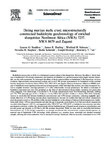Dating martian mafic crust; microstructurally constrained baddeleyite geochronology of enriched shergottites Northwest Africa (NWA) 7257, NWA 8679 and Zagami
| dc.contributor.author | Staddon, LG | |
| dc.contributor.author | Darling, JR | |
| dc.contributor.author | Schwarz, WH | |
| dc.contributor.author | Stephen, Natasha | |
| dc.contributor.author | Schuindt, S | |
| dc.contributor.author | Dunlop, J | |
| dc.contributor.author | Tait, KT | |
| dc.date.accessioned | 2021-10-25T11:50:29Z | |
| dc.date.available | 2021-10-25T11:50:29Z | |
| dc.date.issued | 2021-12-15 | |
| dc.identifier.issn | 0016-7037 | |
| dc.identifier.issn | 1872-9533 | |
| dc.identifier.uri | http://hdl.handle.net/10026.1/18173 | |
| dc.description.abstract |
Baddeleyite (monoclinic; m-ZrO2) is a widespread accessory phase within shergottites. However, the effects of shock loading on baddeleyite U-Pb isotopic systematics, and therefore its reliability as a geochronometer within highly shocked lithologies, are less well constrained. To investigate the effects of shock metamorphism on baddeleyite U-Pb chronology, we have conducted high-resolution microstructural analysis and in-situ U-Pb isotopic measurements for baddeleyite within enriched basaltic shergottites Northwest Africa (NWA) 7257, NWA 8679 and Zagami. Electron backscatter diffraction (EBSD) analyses of baddeleyite reveal significant microstructural heterogeneity within individual thin sections, recording widespread partial to complete reversion from high-pressure (≥3.3 GPa) orthorhombic zirconia polymorphs. We define a continuum of baddeleyite microstructures into four groupings on the basis of microstructural characteristics, including rare grains that retain magmatic twin relationships. Uncorrected U-Pb isotopic measurements form Tera-Wasserburg discordia, yielding new 238U-206Pb discordia ages of 195 ± 15 Ma (n = 17) for NWA 7257 and 220 ± 23 Ma (n = 10) for NWA 8679. Critically, there is no resolvable link between baddeleyite microstructure and U-Pb isotope systematics, indicating negligible open-system behaviour of U-Pb during zirconia phase transformations. Instead, we confirm that high post-shock temperatures exert the greatest control on Pb mobility within shocked baddeleyite; in the absence of high post-shock temperatures, baddeleyite yield robust U-Pb isotope systematics and date the age of magmatic crystallization. Low bulk post-shock temperatures recorded within Zagami (≤220 °C), and suggested within NWA 7257 and NWA 8679 by baddeleyite microstructure and other petrological constraints, confirm that the previously derived baddeleyite age of Zagami records magmatic crystallization, and provide greater age diversity to 225 Ma to 160 Ma enriched shergottites. While our data yield no resolvable link between microstructure and U-Pb isotopic composition, we strongly recommend that microstructural analyses should represent an essential step of baddeleyite U-Pb chronology within planetary (e.g., martian, lunar, asteroidal) and shocked terrestrial samples, allowing full contextualisation prior to destructive isotopic techniques. Microstructurally constrained in-situ U-Pb analyses of baddeleyite thus define new opportunities for the absolute chronology of martian meteorites and, more broadly, shocked planetary materials. | |
| dc.format.extent | 73-88 | |
| dc.language | en | |
| dc.language.iso | en | |
| dc.publisher | Meteoritical Society | |
| dc.subject | Baddeleyite | |
| dc.subject | Shergottite | |
| dc.subject | Chronology | |
| dc.subject | EBSD | |
| dc.subject | Shock metamorphism | |
| dc.title | Dating martian mafic crust; microstructurally constrained baddeleyite geochronology of enriched shergottites Northwest Africa (NWA) 7257, NWA 8679 and Zagami | |
| dc.type | journal-article | |
| dc.type | Journal Article | |
| plymouth.author-url | https://www.webofscience.com/api/gateway?GWVersion=2&SrcApp=PARTNER_APP&SrcAuth=LinksAMR&KeyUT=WOS:000710903700003&DestLinkType=FullRecord&DestApp=ALL_WOS&UsrCustomerID=11bb513d99f797142bcfeffcc58ea008 | |
| plymouth.volume | 315 | |
| plymouth.publication-status | Published | |
| plymouth.journal | Geochimica et Cosmochimica Acta | |
| dc.identifier.doi | 10.1016/j.gca.2021.09.034 | |
| plymouth.organisational-group | /Plymouth | |
| plymouth.organisational-group | /Plymouth/Faculty of Science and Engineering | |
| plymouth.organisational-group | /Plymouth/Faculty of Science and Engineering/School of Geography, Earth and Environmental Sciences | |
| plymouth.organisational-group | /Plymouth/Faculty of Science and Engineering/School of Geography, Earth and Environmental Sciences/SoGEES - Manual | |
| plymouth.organisational-group | /Plymouth/REF 2021 Researchers by UoA | |
| plymouth.organisational-group | /Plymouth/REF 2021 Researchers by UoA/UoA07 Earth Systems and Environmental Sciences | |
| plymouth.organisational-group | /Plymouth/Users by role | |
| plymouth.organisational-group | /Plymouth/Users by role/Academics | |
| dcterms.dateAccepted | 2021-09-27 | |
| dc.rights.embargodate | 2021-10-26 | |
| dc.identifier.eissn | 1872-9533 | |
| dc.rights.embargoperiod | Not known | |
| rioxxterms.versionofrecord | 10.1016/j.gca.2021.09.034 | |
| rioxxterms.licenseref.uri | http://www.rioxx.net/licenses/all-rights-reserved | |
| rioxxterms.licenseref.startdate | 2021-12-15 | |
| rioxxterms.type | Journal Article/Review |


